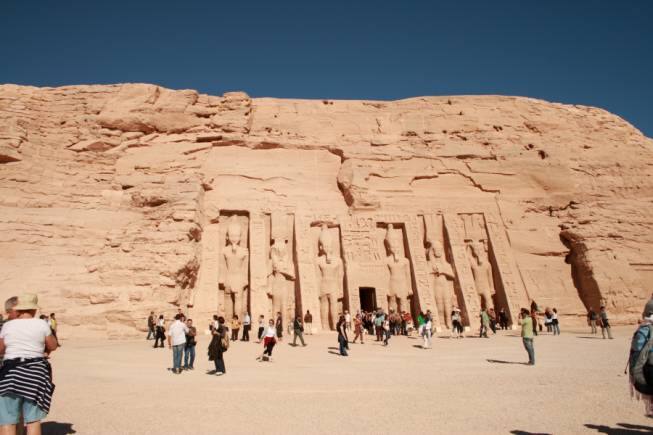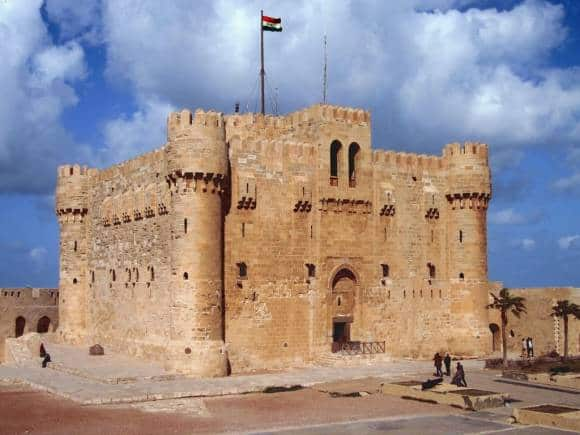



It’s a rare traveller who is not at some point besotted with the idea of visiting the pyramids of Egypt. The sheer sight of them is enough to take the breath away. Nearby, the enigmatic and inscrutable sphinx only adds to the sense of wonder and fascination. But Egypt is blessed with historical and cultural riches that are simply stunning; it conjures up images of hieroglyphs and Cleopatra, of majestic Egyptian Gods and graceful feluccas on the Nile, and so much more.
Now with Indians having the added advantage of getting a single-entry visa on arrival, valid for 30 days, an Egyptian odyssey is that much more easy.
Here are the places to see and things to do beyond the pyramids, from sphinxes to river cruise and ancient temples, library, catacombs, forts and lighthouse:
Cairo and Giza: Beyond pyramids, sphinx calls
 Giza Necropolis is a funerary temple complex with nine pyramids. The biggest measures 146m in height. (Photo: Anita Rao Kashi)
Giza Necropolis is a funerary temple complex with nine pyramids. The biggest measures 146m in height. (Photo: Anita Rao Kashi)
The place to start is at the capital Cairo, a city that straddles several ages with fantastic ancient mosques and museums replete with art and artefacts sitting side by side with glittery high-rises and swanky boulevards.
But the best place to get a true glimpse of Cairo is at Khan al Khalili market, a maze of tiny lanes packed with shops and eateries. True, it is a bit of a tourist trap, but it is also a great place to sit at a roadside café and watch humanity pass by.
Cairo is also just the entry point to the world’s most iconic monuments — pyramids and the sphinx. Head to the other side from the entryway where golden deserts stretch to the horizon amid which sit a set of pyramids and the sphinx, which have all been here for more than 4,500 years.
Giza Necropolis is a funerary temple complex with some nine pyramids, but only three are arresting. Up close they are even more breathtaking, the biggest measuring 146m in height.
 The Great Sphinx of Giza is a limestone statue of a reclining sphinx, a mythical creature with the head of a human, and the body of a lion. (Photo: Anita Rao Kashi)
The Great Sphinx of Giza is a limestone statue of a reclining sphinx, a mythical creature with the head of a human, and the body of a lion. (Photo: Anita Rao Kashi)
In front of them is the sphinx, even more mysterious in reality. Some of the pyramids, can be visited inside, but it can be a bit of a claustrophobic experience.
Luxor: Temples galore
Nearly 700 km to the south of Cairo, with the Nile flowing through the middle, Luxor is a fascinating city. On both banks of the river are some of the most magnificent monuments, stupendous in size and incredibly beautiful in design and architecture. On the East Bank is the Luxor temple built by Pharaoh Amenhotep III with its avenue of sphinxes, the stunning obelisk whose twin stands in the Place de la Concorde in Paris, statues of Ramesses II and the gigantic colonnades.
 On the East Bank of Nile is the Luxor temple built by Pharaoh Amenhotep III with its avenue of sphinxes, statues of Ramesses II and the gigantic colonnades. (Photo: Anita Rao Kashi)
On the East Bank of Nile is the Luxor temple built by Pharaoh Amenhotep III with its avenue of sphinxes, statues of Ramesses II and the gigantic colonnades. (Photo: Anita Rao Kashi)
Further up is the Karnak temple complex, a dramatic collection of sanctuaries, obelisks, carved colonnades, pylons, the avenue of Ram-headed sphinxes and more statues of Ramesses II. And on the West bank is the Valley of Kings, known more as a valley of death. Overwhelming in a bleak and forlorn sense, it is full of scorching stone cliffs and bare, and the grand location for some 62 tombs belonging to various Theban royals, especially a line of Ramesses from various dynasties.
 The Karnak temple complex is a dramatic collection of sanctuaries, obelisks, carved colonnades, pylons, Ram-headed sphinxes and more statues of Ramesses II. (Photo: Anita Rao Kashi)
The Karnak temple complex is a dramatic collection of sanctuaries, obelisks, carved colonnades, pylons, Ram-headed sphinxes and more statues of Ramesses II. (Photo: Anita Rao Kashi)
Nearby, in complete contrast, is the Temple of Hatshepsut, carved into the mountain face and standing in dramatic grandeur against the backdrop of rising cliffs.
 Hatshepsut temple is a contrast to the other temples. Carved into the mountain face, it stands against rising cliffs. (Photo: Anita Rao Kashi)
Hatshepsut temple is a contrast to the other temples. Carved into the mountain face, it stands against rising cliffs. (Photo: Anita Rao Kashi)
Abu Simbel
Almost at the southern border of Egypt, just 40 km from the Sudan, set amid sprawling desserts and an incredibly blue sky, are the Temples of Abu Simbel rising dramatically from Lake Nasser. It is hard not to be awestruck by the four colossal statues of Ramesses towering 65 ft into the sky. Carved out of sheer rock face, these temples were buried, until they were discovered by chance and reconstructed on higher ground. Built by Pharaoh Ramesses II as a tribute to the gods Ra-Harakthy (god of sun and sky), Amun (a local creator god) and Ptah (god of creativity), the colossal structure is nevertheless a deification of himself as is evident by the four gigantic statues. Adjacent is the temple of goddess Hathor (goddess of love and music), dedicated to the Pharaoh’s loved wife Nefertari.
 The Temples of Abu Simbel, in southern Egypt, 40 km from the Sudan, on sprawling deserts, rise dramatically from Lake Nasser. (Photo: Anita Rao Kashi)
The Temples of Abu Simbel, in southern Egypt, 40 km from the Sudan, on sprawling deserts, rise dramatically from Lake Nasser. (Photo: Anita Rao Kashi)
Nile cruise for temple run
One of the best ways to include all the monuments is with a three- or a five-day cruise down the Nile since most are situated on the river’s banks. It is also possible to catch other lesser but no-less-spectacular sights along the way. Such as Edfu with its Temple of Horus (falcon-headed God of the pharaohs); Temple of Kom Ombo, a spectacular edifice dedicated to Sobek, the crocodile king; and Isis at Philae, dating back to the 4th century BC, with beautiful pillars, massive walls with inscriptions and majestic sanctuaries.
 One of the best ways to include all the Egyptian monuments in your itinerary is with a cruise down the Nile since most are situated on the river’s banks. (Photo: Anita Rao Kashi)
One of the best ways to include all the Egyptian monuments in your itinerary is with a cruise down the Nile since most are situated on the river’s banks. (Photo: Anita Rao Kashi)
Alexandria: Library, fort, catacombs, lighthouse
In complete contrast, Alexandria on the Mediterranean coast is vibrant and much more modern, but has its own colourful history. It was founded by Alexander the Great and ruled by the most famous woman in history — Cleopatra.
 Bibliotheca Alexandrina (pictured, a flat, circular structure) is inspired by the ancient library and contains age-old manuscripts and books. (Photo: Wikimedia Commons)
Bibliotheca Alexandrina (pictured, a flat, circular structure) is inspired by the ancient library and contains age-old manuscripts and books. (Photo: Wikimedia Commons)
Sadly, there’s nothing to show for either of them, but there’s something magnificent — Bibliotheca Alexandrina, which is inspired by the ancient library and contains age-old manuscripts and books.
 Catacombs of Kom Ash-Shuqqafa, a Roman burial site. (Photo: Wikimedia Commons)
Catacombs of Kom Ash-Shuqqafa, a Roman burial site. (Photo: Wikimedia Commons)
Worth a visit are Catacombs of Kom Ash-Shuqqafa, a Roman burial site and rather creepy, and Fort Qaitbey, a 15th century fort and site of the pharaohs, the ancient lighthouse built in 3rd century BC by the Romans.
 Fort Qaitbey, a 15th century fort and site of the pharaohs, in Alexandria. (Photo: Wikimedia Commons)
Fort Qaitbey, a 15th century fort and site of the pharaohs, in Alexandria. (Photo: Wikimedia Commons)
The journey from the sea-side beauty of Alexandria to the splendour of Abu Simbel feels more like a journey through time, with the weight of history a constant companion.
 The Pharos of Abuqir, a likely copy of the famed lighthouse of Alexandria, adorns an ancient tomb. (Photo: Wikimedia Commons)
The Pharos of Abuqir, a likely copy of the famed lighthouse of Alexandria, adorns an ancient tomb. (Photo: Wikimedia Commons)
At the end, it is all rather overwhelming, but also deeply satisfying.
Discover the latest Business News, Sensex, and Nifty updates. Obtain Personal Finance insights, tax queries, and expert opinions on Moneycontrol or download the Moneycontrol App to stay updated!
Find the best of Al News in one place, specially curated for you every weekend.
Stay on top of the latest tech trends and biggest startup news.